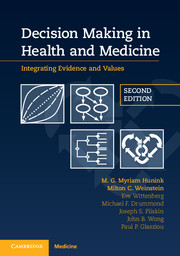Book contents
- Frontmatter
- Dedication
- Contents
- Foreword
- Foreword to the first edition (2001)
- Preface
- Acknowledgments
- list of Abbreviations
- About the authors
- 1 Elements of decision making in health care
- 2 Managing uncertainty
- 3 Choosing the best treatment
- 4 Valuing outcomes
- 5 Interpreting diagnostic information
- 6 Deciding when to test
- 7 Multiple test results
- 8 Finding and summarizing the evidence
- 9 Constrained resources
- 10 Recurring events
- 11 Estimation, calibration, and validation
- 12 Heterogeneity and uncertainty
- 13 Psychology of judgment and choice
- Index
- References
9 - Constrained resources
Published online by Cambridge University Press: 05 October 2014
- Frontmatter
- Dedication
- Contents
- Foreword
- Foreword to the first edition (2001)
- Preface
- Acknowledgments
- list of Abbreviations
- About the authors
- 1 Elements of decision making in health care
- 2 Managing uncertainty
- 3 Choosing the best treatment
- 4 Valuing outcomes
- 5 Interpreting diagnostic information
- 6 Deciding when to test
- 7 Multiple test results
- 8 Finding and summarizing the evidence
- 9 Constrained resources
- 10 Recurring events
- 11 Estimation, calibration, and validation
- 12 Heterogeneity and uncertainty
- 13 Psychology of judgment and choice
- Index
- References
Summary
There is no question that financial and medical effects will both be considered when making health care decisions at all levels of policymaking; the only question is whether they will be considered well.
Elaine J. Power and John M. EisenbergIntroduction
Medical care entails benefits, harms, and costs. Until this chapter our approach has involved weighing benefits against harms for individuals and groups of patients and choosing the actions that provide the greatest expected health benefit. Now we extend our analysis to consider expressly the economic costs of health care and resource allocation decisions for populations.
As with all economic goods and services, the provision of health care consumes resources. Hospital beds, medical office facilities, medical equipment, pharmaceuticals, medical devices, and the time of physicians, nurses, other health-care workers, and family members all contribute to health care. The consumption of these resources constitutes the economic costs of health care.
- Type
- Chapter
- Information
- Decision Making in Health and MedicineIntegrating Evidence and Values, pp. 237 - 299Publisher: Cambridge University PressPrint publication year: 2014
References
- 1
- Cited by

